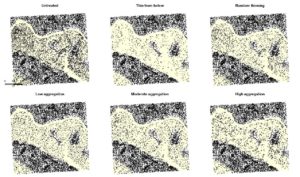 This paper examines how heterogeneous restoration treatments impact light availability using a combined field and simulation approach that is now available online. One of the major take-aways is that altering spatial pattern of overstory trees presents several trade-offs among effects on tree density, structural complexity, and the light environment, and modeling approaches can help uncover these trade-offs for a range of scenarios.
This paper examines how heterogeneous restoration treatments impact light availability using a combined field and simulation approach that is now available online. One of the major take-aways is that altering spatial pattern of overstory trees presents several trade-offs among effects on tree density, structural complexity, and the light environment, and modeling approaches can help uncover these trade-offs for a range of scenarios.
There is limited information on how a range of spatial outcomes from restoration treatments
can influence structural complexity and tree regeneration dynamics in mixed conifer stands. In this
study, we model understory light levels across a range of forest density in a stem-mapped dry mixed
conifer forest and apply this model to simulated stem maps that are similar in residual basal area
yet vary in degree of spatial complexity. We found that light availability was best modeled by
residual stand density index and that consideration of forest structure at multiple spatial scales is
important for predicting light availability. Second, we found that restoration treatments differing
in spatial pattern may differ markedly in their achievement of objectives such as density reduction,
maintenance of horizontal and tree size complexity, and creation of microsite conditions favorable
to shade-intolerant species, with several notable trade-offs. These conditions in turn have cascading
effects on regeneration dynamics, treatment longevity, fire behavior, and resilience to disturbances.
In our study, treatments with high aggregation of residual trees best balanced multiple objectives
typically used in ponderosa pine and dry mixed conifer forests.
